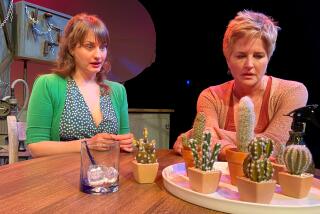Some Arcane Scientific Jargon Clouds ‘Oxygen’
- Share via
SAN DIEGO — In theater as in chemistry, having the correct mix is crucial. So the two noted scientist-writers of “Oxygen” need to take their concoction back to their beakers and Bunsen burners to add more drama.
“Oxygen” is getting its world debut for a week on the San Diego Rep’s Lyceum Stage, concurrent with a downtown convention of the American Chemical Society. It’s great programming for the select audience. But although authors Carl Djerassi and Roald Hoffmann have commendably made considerable arcana accessible, nonscientists may drown in the flood of terminology. Additionally, the drama’s time-tripping story line remains muddled, and the whole is much heavier on exposition than exhibition.
Djerassi, considered the father of the contraceptive pill, is a professor at Stanford University and has written several books in a genre he terms “science-in-fiction.” Hoffmann, a professor at Cornell University, won the 1981 Nobel Prize in chemistry and has published books of poetry and nonfiction.
The play’s central theme is the question of how discoveries should be credited. As a clever plot device, this year’s Nobel committee has decided to commemorate the prizes’ centenary by inaugurating a retroactive award for great discoveries that preceded the 20th century. In chemistry, the obvious choice is oxygen. But then comes the sticky problem: Who deserves the prize?
Frenchman Antoine Lavoisier is generally regarded as the architect of modern chemistry because of his work with oxygen. Previously, however, experiments by English clergyman Joseph Priestley and Swedish apothecary Carl Wilhelm Scheele produced the gaseous element. But the two failed to analyze its properties the way Lavoisier did.
In life, the men apparently never met. In the play, they and their wives are invited to Stockholm in 1777 by King Gustav III to decide among themselves who should receive a medal. Meanwhile, the 2001 panel comprises three men and a chairwoman. When they can’t agree on a nominee, the chairwoman assigns each man to make the case for one of the candidates, whom they become in the parallel story.
It’s a tricky duality, and neither the script nor director Bryan Bevell has effectively meshed the disparate elements into a single focus. Melanie Watnick’s costuming generally helps, as the actors switch from one era to another by adding or removing a garment. And David Cuthbert’s lighting cues the transitions. But David Weiner’s set--utilitarian with three large screens for helpful slide projections, a mirrored dressing screen, a table and a tiered platform--is flanked by mannequins in 18th century gowns, visually overemphasizing the early era.
A stronger cast would help, particularly because all six have to play two roles. But because the dialogue has to be so explanatory, it’s somewhat understandable if the actors slip into pedantic recitation. And having to deliver a sentence that’s split with the clause “the curator as excited as I” would challenge Olivier. Most consistent were Randall Dodge as Lavoisier and his researcher, and Diane Addis as the chairwoman and Mrs. Priestley.
“Oxygen” may ignite with the visiting chemists, but others may not find the antagonism between theoreticians and experimentalists all that involving, or lines like “Quantitative analysis is a hard mistress” all that rib-tickling.
*
* “Oxygen,” Lyceum Space, Horton Plaza, San Diego. Today at 5 and 8:30 p.m., Thursday-Saturday at 8 p.m., ends Saturday. $22-38. (619) 544-1000. Running time: 2 hours.
More to Read
The biggest entertainment stories
Get our big stories about Hollywood, film, television, music, arts, culture and more right in your inbox as soon as they publish.
You may occasionally receive promotional content from the Los Angeles Times.










